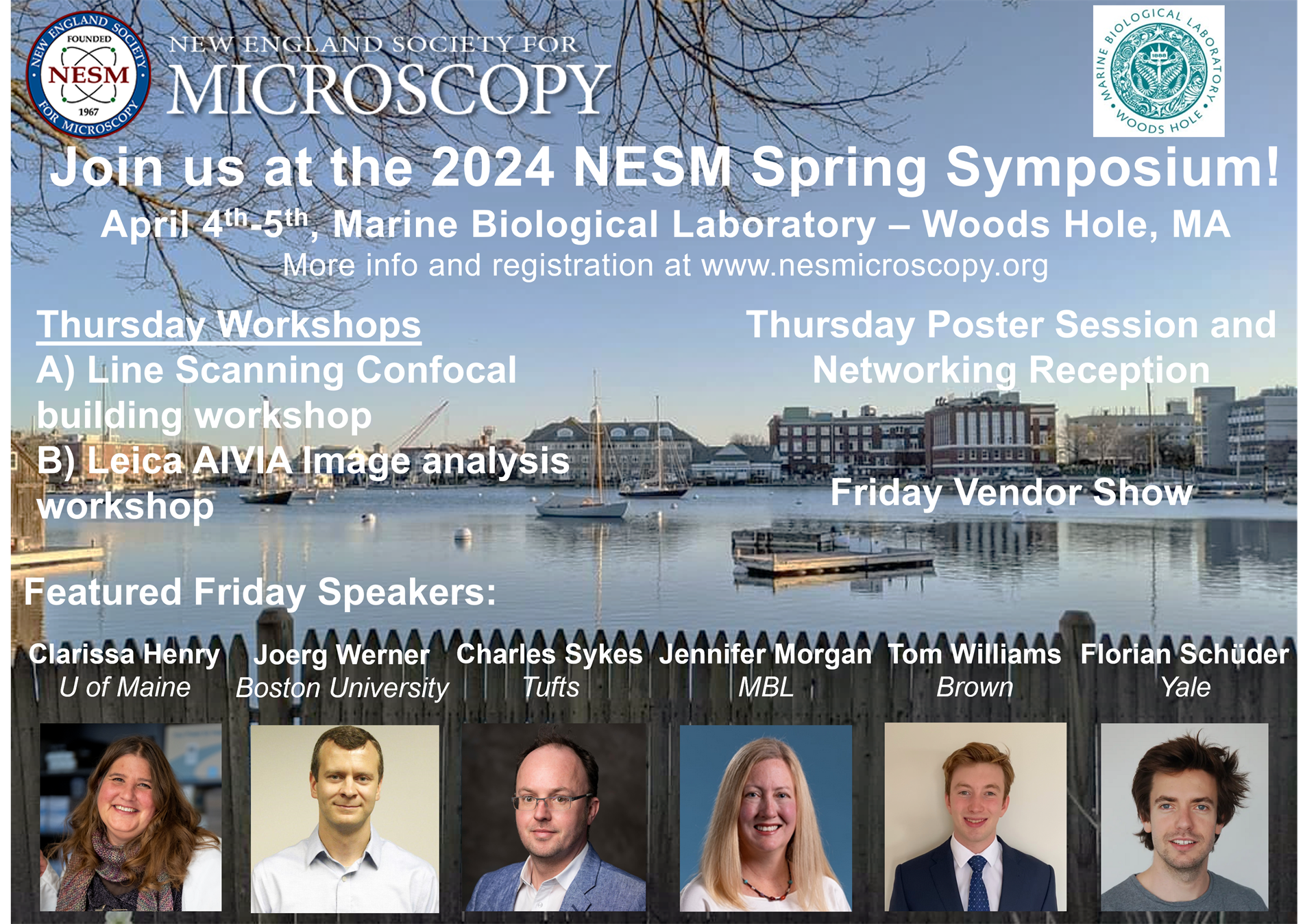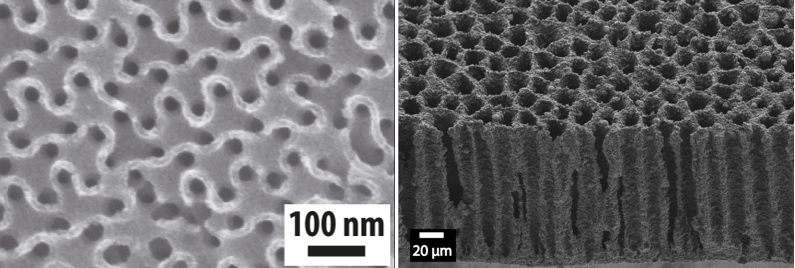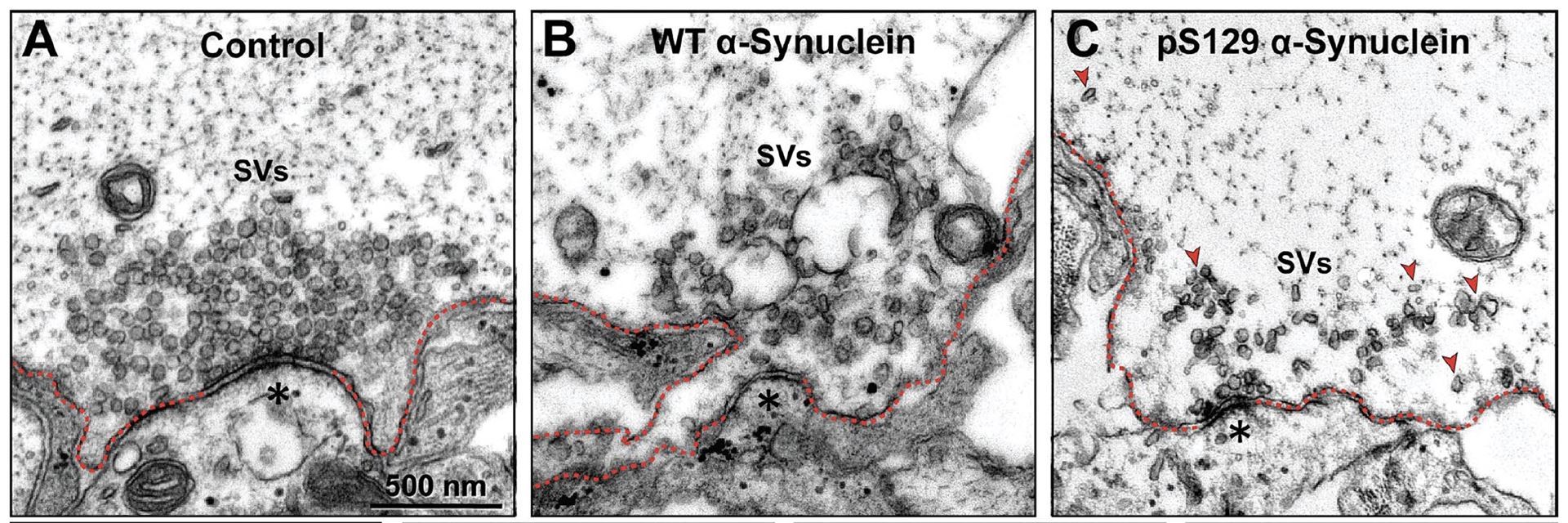
You are invited to the New England Society for Microscopy's Annual Spring Workshop & Symposium at the Marine Biological Laboratory in Woods Hole, Massachusetts! The meeting will be held over two days - Thursday, April 4th and Friday, April 5th. On Thursday we will have a workshop on in the afternoon, a Poster Session (with a poster prize!) and Networking Drinks Reception in the early evening. Friday will consist of a day-long Symposium featuring six technical talks, four 10-minute "lightning" talks and an exhibiting vendor session. We have an exciting selection of speakers covering topics at the cutting edge of microscopy in the biological and physical sciences. These speakers are Jennifer Morgan (MBL), Tom Williams (Brown), Clarissa Henry (University of Maine), Charles Sykes (Tufts), Florian Schüder (Yale) and Joerg Werner (Boston University). You can read speaker bios and abstracts at the bottom of this page.
Accommodation at MBL
You can also sign up for accommodation at MBL. You can select a single or shared room. Accommodation fees are in addition to the meeting registration fee. We also have negotiated a discount for the Woods Hole Inn. After entering the dates select special rates, click promotional code and enter code "SCIENCE" for 10% off your stay.
We are looking forward to seeing everyone in-person this year!
Thursday April 4th
1:00pm Welcoming Remarks
1:10pm Workshop Part 1
2:30pm Coffee break
3:00pm Workshop Part 2
5:00pm Poster session and Networking Drinks reception
7:00pm Closing
Friday April 5th
9:00am Registration and Breakfast
9:50am Welcome by Stephan Kramer NESM President
10:00am Jennifer Morgan - Using Imaging to Gain Insights into Synaptic Defects in Parkinson’s Disease
10:35am Tom Williams - Inferring Lunar Volcanic Gas Cloud Evolution from Atom Probe and TEM Analyses of Apollo 17 Glasses
11:10am Vendor Fair
12:10pm Lunch
1:00pm Business meeting and elections
1:10pm Clarissa Henry - Super-Resolution imaging reveals subdomains in the skeletal muscle membrane
1:45pm Lightning talk #1 - Jaqulin Wallace
1:55pm Lightning Talk #2 - Vlad Botchkarev
2.05pm Charles Sykes - Single-Atom Alloy Catalysts: Born in a Vacuum, Tested in Reactors, and Understood In Silico
2.40pm Lightning talk #3 - Benjamin Muller
2.50pm Lightning Talk #4 - William Ramos
3:00pm Coffee Break and election results
3:20pm Florian Schüder - FLASH-PAINT: Fast and highly multiplexed DNA-PAINT
3:55pm Joerg Werner - Bottom-Up Fabrication of Functional Nanostructured Materials with Polymer Assembly
When arriving at MBL, please check in at the Swope Center Front Desk to receive a parking pass. They will direct you to an available parking lot at that time.
All locations are in the Swope Center located at 5 North Street.
The Workshop and Symposium will be located in the Megis Room in the Swope Center.
Thursday Poster Session and Networking Reception will be in the Swope Private Dining Room
Friday Lunch will be provided in the Main Dining Room, Swope Center.
MBL map

Speaker Info
Professor Clarissa Henry - University of Maine
Bio: Clarissa is a Professor in the School of Biology and Ecology at the University of Maine. She received her PhD in 2000 and was a Miller Postdoctoral Fellow at the University of California Berkeley 2001-2004. She has been at the University of Maine since 2004. Clarissa is currently Director of the NIH-designated Center of Biomedical Research Excellence (COBRE): Extracellular Regulation of Cellular Behavior at the University of Maine.
Abstract: Congenital muscular dystrophies (CMDs) are incurable degenerative neuromuscular diseases. One gap in our understanding of skeletal muscle degeneration in these diseases is that the nanoscale locatio n and distribution of critical transmembrane receptors in the muscle membrane are not known. We collaborated with the Hess laboratory to use fluorescence photoactivation localization microscopy (FPALM) to provide novel insights into the nanoscale organization of transmembrane receptors in intact vertebrate skeletal muscle. These results and potential implications will be discussed. Research was supported by NIAMS R01AR07536.
n and distribution of critical transmembrane receptors in the muscle membrane are not known. We collaborated with the Hess laboratory to use fluorescence photoactivation localization microscopy (FPALM) to provide novel insights into the nanoscale organization of transmembrane receptors in intact vertebrate skeletal muscle. These results and potential implications will be discussed. Research was supported by NIAMS R01AR07536.
Professor Charles Sykes - Tufts University
Bio: Charles Sykes is the John Wade Professor of Chemistry at Tufts University. Charles got his B.S. and M.S. from Oxford University before moving to Cambridge University for a Ph.D. under the supervision of Professor Richard Lambert. He then relocated to the U.S. for a postdoctoral fellowship with Professor Paul Weiss at Penn State before starting his independent career at Tufts University in 2005. Sykes has been named a Beckman Young Investigator, Research Corporation Cottrell Scholar, IUPAC young observer and the Usen Family Career Development Professor. He was also the recipient of a 2009 NSF CAREER award, a 2011 Camille Dreyfus Teacher-Scholar Award and the 2012 AVS Peter Mark Memorial Award. Charles received the Young Talented Scientist Awardat Chirality 2014 and was named a Fellow of the Royal Society of Chemistry in 2015. In 2018 Charles was named a Fellow of the AVS and, together with Maria Flytzani-Stephanopoulos, was awarded the 2019 ACS Catalysis Lectureship for the Advancement of Catalytic Sciences. In 2022 Charles was named a AAAS fellow and awarded the Royal Society of Chemistry, Faraday Division, Horizon Prize for the development of single-atom alloy catalysts. Charles is the 2023 winner of the International Precious Metals Institute, Henry J. Albert Award. He is the author of over 170 peer-reviewed publications and has given over 165 invited talks at conferences and universities.
Abstract: In this talk I will discuss a new class of heterogeneous catalysts called Single-Atom Alloys in which precious, reactive metals are utilized at the ultimate limit of efficiency.1-6 These catalysts were discovered by combining atomic-scale scanning probes with more traditional approaches to study surface-catalyzed chemical reactions. This research provided links between atomic-scale surface structure and reactivity which are key to understanding and ultimately controlling important catalytic processes. In collaboration with Maria Flytzani-Stephanopoulos these concepts derived from our surface science and theoretical calculations have been used to design Single-Atom Alloy nanoparticle catalysts that are shown to perform industrially relevant reactions at realistic reaction conditions. For example, alloying elements like platinum and palladium with cheaper, less reactive host metals like copper enables 1) dramatic cost savings in catalyst manufacture, 2) more selective hydrogenation and dehydrogenation reactions, 3) reduced susceptibility to CO poisoning, and 4) higher resistance to deactivation by coking. I go on to describe very recent theory work by collaborators Stamatakis (Oxford University) and Michaelides (Cambridge University) that predicts reactivity trends for a wide range of Single-Atom Alloy combinations for important reaction steps like H-H, C-H, N-H, O-H, and CO2 activation. Overall, I hope to highlight that this combined surface science, theoretical, and catalyst synthesis and testing approach provides a new and somewhat general method for the a priori design of new heterogeneous catalysts.

References:
[1] Kyriakou et al. Science 335, 1209 (2012).
[2] Marcinkowski et al. Nature Materials 12, 523 (2013).
[3] Lucci et al. Nature Communications 6, 8550 (2015).
[4] Liu et al. JACS 138, 6396 (2016).
[5] Marcinkowski et al. Nature Chemistry 10, 325 (2018).
[6] Hannagan et al. Science 372, 1444 (2021).
Assistant Professor Joerg Werner - Boston University
Bio: Joerg Werner is an Assistant Professor in Mechanical Engineering and Materials Science at Boston University since 2020. He received his Diplom in Chemistry in 2011 from the Johannes Gutenberg University in Mainz, Germany, and his PhD in 2016 from the Department of Chemistry at Cornell University. At Cornell under the guidance of Prof. Uli Wiesner (MSE), he developed 3D ordered and nanostructured functional architectures for next-generation energy storage applications using block copolymer co-assembly. Subsequently, he joined the group of Prof. Dave Weitz at Harvard University as a postdoc, where he developed reversibly stimuli-responsive microcapsules from microfluidic complex emulsion templating. At BU, the Werner group focuses on spatially controlled syntheses and bottom-up fabrication methods to study the interplay of functional materials with 3D structures across scales, utilizing polymer self-assembly, phase separation, and electrodeposition. In 2023, Prof. Werner received the DARPA Young Faculty Award.
Abstract: Advanced manufacturing of metamaterials and application-tailored architectures requires control over structural features on the nano- to the microscale within bulk materials. A plethora of fabrication methods for nanoscaled materials have been discovered and developed over the past decades, both for individual nanomaterials such as particles (0-D), rods/tubes (1-D), and sheets (2-D), as well as for thin film and surface patterns. However, scalable processes for 3-D nano/micro-architected materials with extended macroscopic dimensions remain inadequate. We utilize and explore soft-matter phase behavior to achieve nano- and micro-structuring in bulk volumes. In this talk, I will introduce block copolymer (BCP) structure direction for the tunable bottom-up fabrication of monolithic functional materials with intrinsic ordered periodic 3-D nanostructure. I will highlight both the traditional BCP co-assembly as well as an emerging concept of selective infusion templating that we are developing. Subsequently, I will briefly introduce our advances in the fabrication of monolithic anisotropic micro-architectures for energy storage electrodes by controlling the phase inversion of hybrid suspensions containing soft and hard matter.
Florian Schüder - Yale University
Bio: Florian Schüder studied Physics at the Ludwig-Maximilians University of Munich and the Wyss Institute for Biologically Inspired Engineering at Harvard University from 2009 to 2015. Afterward, he pursued a Ph.D. in Biophysics at the Max Planck Institute of Biochemistry in Martinsried from 2015 to 2020. Since 2021, he has been a Postdoctoral Fellow in the group of Joerg Bewersdorf and Jorge E. Galan at Yale University.
Abstract: Fluorescence microscopy, an important and widely used tool in biological research, has witnessed a true renaissance since the invention of methods that circumvent the so-called diffraction limit, namely super-resolution techniques. In resonance with these advancements, my work combines advanced high-resolution microscopy with novel approaches from the field of DNA nanotechnology to push the limits of light microscopy and apply it to cell-biological research. In this presentation, I will describe current advances in DNA-based super-resolution microscopy, regarding image acquisition speed, and spectrally unlimited multiplexed imaging.
Jennifer Morgan - MBL
Bio: Dr. Morgan is a Senior Scientist and Director for The Eugene Bell Center for Regenerative Biology and Tissue Engineering at the MBL. Dr. Morgan’s research program focuses on the basic mechanisms of synapse function, as well as synaptic mechanisms that contribute to neurodegenerative diseases such as Parkinson’s disease and dementia with Lewy bodies. This research has been continuously funded by the National Institutes of Health (NIH) for over a decade. Dr. Morgan is a recipient of a University of Texas Regents’ Outstanding Teaching Award, as well as the Janett Trubatch Career Development Award from the Society for Neuroscience. She currently serves on an NIH study section, Neuronal Communication. Throughout her career, Dr. Morgan has dedicated her efforts to teaching and mentoring, and especially providing research experiences for junior scientists at the MBL, which is how her own career in science began.
Abstract: α-Synuclein is a presynaptic protein that regulates synaptic vesicle trafficking under normal, physiological conditions. In Parkinson’s disease (PD), Lewy body dementia, and some variants of Alzheimer’s disease, α-synuclein aberrantly aggregates throughout neurons, including in presynaptic nerve terminals. However, the cellular and molecular impacts of excess synaptic α-synuclein accumulation remain unclear. Our lab has developed the giant reticulospinal synapse of sea lamprey as a model for identifying the acute impacts of excess α-synuclein on synaptic vesicle trafficking. We have used this unique model to reveal the synaptic effects of numerous molecular species of α-synuclein, including PD-associated variants. In this presentation, I will share some of our recent findings on how excess α-synuclein affects the cell biology of the synapse and how we use light and electron microscopy to address the open questions.

Tom Williams - Brown
Bio: Originally from the UK, I graduated from Oxford University with an MSc in Earth Sciences in 2020. I am now pursuing a PhD in the Department of Earth, Environmental, and Planetary Sciences at Brown University, where I work with Prof. Stephen Parman and Prof. Alberto Saal. My research interests focus mainly on the behavior of volatile elements in volcanic processes. This includes deepening our understanding of lunar volcanic eruptions, and determining how magmatic noble gas ratios are affected by kinetic processes.
Abstract: The primary goal of this study is to identify the mineralogy of phases on the surface of Apollo 17 lunar glass beads and use this information to reconstruct the conditions within the lunar volcanic gas clouds from which they de-sublimated. To achieve this, we first characterized the mineralogy of the nano-polycrystalline bead coatings using a comprehensive suite of analytical tools including TEM, APT, and NanoSIMS. This procedure was completed with no atmospheric exposure, as the coatings are highly reactive to air. Finally, we utilized a thermodynamic model to determine the composition and physical conditions (pressure, temperature, oxygen fugacity) within the volcanic gas cloud under which these coatings could form.
